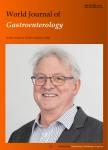Asymmetric dimethylarginine:A novel biomarker of gastric mucosal injury?
Asymmetric dimethylarginine:A novel biomarker of gastric mucosal injury?作者机构:Department of Pharmacology School of Pharmaceutical Sciences Central South University Changsha 410078 Hunan Province China Department of Digestive Medicine Xiang-Ya Hospital Central South University Changsha 410078 Hunan Province China
出 版 物:《World Journal of Gastroenterology》 (世界胃肠病学杂志(英文版))
年 卷 期:2011年第17卷第17期
页 面:2178-2180页
核心收录:
学科分类:10[医学]
主 题:Asymmetric dimethylarginine Mucosal injury Nitric oxide
摘 要:Nitric oxide(NO),a multifunctional endogenous gas molecule,is metabolized from L-arginine by enzymatic reaction in the presence of nitric oxide ***,an important gas signaling molecule,is a gastric mucosa protective factor that contributes significantly to maintain normal gastric mucosa *** increases gastric mucosa blood flow,regulates the secretion of mucus and bicarbonate,and inhibits the secretion of gastric *** dimethylarginine(ADMA) has been identified as the major endogenous inhibitor of nitric oxide *** function of ADMA is to decrease NO production via inhibiting nitric oxide synthase *** inhibiting NO synthesis,ADMA also directly induces oxidative stress and cell apoptosis,and participates in inflammation *** systemic accumulation was observed in conjunction with several cardiovascular and metabolic *** also mediates gastric ulcer injury induced by ethanol,stress,helicobacter pylori and *** mechanism of ADMA directly producing adverse effect in gastric mucosa is incompletely *** is widely accepted that NO bioavailability decrease is the majority *** of apoptosis and aggravation of inflammation may be other important mechanisms of ADMA-induced gastric *** might be a novel clinical and experimental biomarker related to gastric mucosa *** therapeutic tool targeting to ADMA is available in multiple cardiovascular diseases,it is unknown in gastrointestinal *** strategy to inhibit ADMA is beneficial to gastric ulcer induced by ethanol in ***,ADMA might be a candidate of therapeutic target in gastric mucosa damage.




